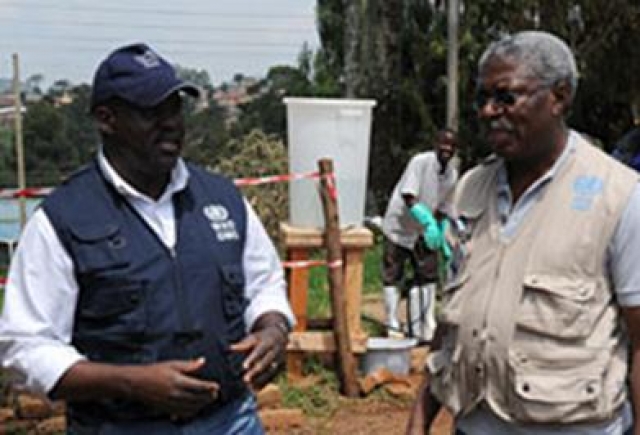Uganda: Quick detection, vigorous public health response hasten end of Ebola outbreak
 Brazzaville, 19 October 2012 -- When the tell-tale signs of an emerging epidemic in Uganda were first confirmed on 28 July 2012, the country’s health authorities, working with World Health Organization (WHO) and other health partners, knew exactly what to do: strive for timely detection of outbreak and mount a vigorous public health response.
Brazzaville, 19 October 2012 -- When the tell-tale signs of an emerging epidemic in Uganda were first confirmed on 28 July 2012, the country’s health authorities, working with World Health Organization (WHO) and other health partners, knew exactly what to do: strive for timely detection of outbreak and mount a vigorous public health response.
It was Uganda’s fourth Ebola outbreak in 12 years; and by the time it was declared over on 4 October, hospital records were showing 17 deaths due to the disease. In all, 104 laboratory specimens were collected and tested by the Uganda Virus Research Institute (UVRI). During the outbreak, 24 probable and confirmed cases were recorded -- 11 of them positively identified as Ebola disease.
“Following the laboratory confirmation of the outbreak, we immediately sent a team with specialists and supplies to Kibaale district, where the outbreak began,” explains Dr Joaquim Saweka, the WHO Representative in Uganda. “Thus we were able to assist the district with the immediate response and effective coordination in the field.”
In a classic example of good outbreak communication, the Ministry of Health together with WHO jointly issued an early first announcement to alert the general public and the international community to the outbreak. Ugandan President Yoweri Museveni later added the weight of his authority to this announcement in a statement on public radio and television.
He told his compatriots: “Ebola spreads by contact …avoid shaking hands because that can cause contact through sweat… Do not take on burying somebody who has died from symptoms that look like Ebola – instead call healthcare workers because they know how to do it”. The evidence is that Ugandans listened and complied.
Breaking the human-to-human transmission cycle remains the cornerstone of infection prevention and control during an Ebola outbreak, and the prompt diagnosis which led to effective identification of the disease by UVRI allowed for the quick introduction of appropriate response measures.
A multi-sectoral, multi-disciplinary Ebola National Task Force (NTF) constituted in 2000 during the first Ebola outbreak was reactivated to ensure effective coordination of the response efforts. Subsequently, an operational Ebola District Task Force was formed in Kibaale district, the epicentre of the outbreak, to coordinate and monitor the implementation of field activities. The NTF immediately developed an emergency response plan aimed at- reducing morbidity and mortality due to Ebola through prompt identification and effective management of cases; effective social mobilization; and coordination of the epidemic response activities.
Other core infection control activities undertaken included the creation of isolation units for suspected cases at Kagaadi hospital and the Mulago National Referral Hospital in Kampala to reduce the potential risk of transmission by minimizing community exposure; timely contact tracing and monitoring; provision of adequate barrier personal protection gear for health care workers and safe burials (these were supplied by MSF, WHO and CDC) and supplies of medical items, food and non-food items. In early August, as the epidemic evolved and the number of admission cases increased, WHO contracted and deployed additional health workers with experience in public health response to Ebola.
These success factors were complemented by intense social mobilization and public information activities (including the designation of the WHO Representative and the chairman of the National Task Force as official spokespersons on the outbreak as well as the production of messages and other information material in local languages); public enlightenment about the virus and its ways of transmission, and good coordination of disparate national and international partners.
With the successful containment of the fourth outbreak, confidence is growing among partners and within Uganda itself that the country could repeat this feat if another outbreak occurs in the future.
Responding to a question on Twitter on 3 August, Ugandan Prime Minister, Hon. Amama Mbabazi said: “Uganda has suffered three previous outbreaks of Ebola and we've built reasonable capacity to manage it”.
The international response to the fourth Ebola outbreak in Uganda involved experts from a number of local and external organizations: the African Field Epidemiology Network, EMESCO Foundation (a local NGO), Infectious Diseases Institute, Uganda Red Cross Society, MSF, UNICEF,CDC, USAID and WHO, which also co-ordinated with the Global Outbreak Alert and Response Network partners
_____________________________________________________________
For more information, please contact:
Benjamin Sensasi sensasib [at] ug.afro.who.int (sensasib[at]ug[dot]afro[dot]who[dot]int) Tel: +256-41-334400
Dr Christine Kisia kisiac [at] ke.afro.who.int (kisiac[at]ke[dot]afro[dot]who[dot]int) Tel: +254 20-2717902
Communication, Advocacy and Media Unit: cam [at] afro.who.int (cam[at]afro[dot]who[dot]int) Tel: +47-241-39378


